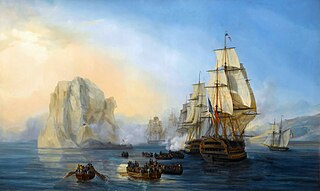Five ships and a shore establishment of the Royal Navy have been named HMS Mersey after the River Mersey:
Six ships and a training establishment of the Royal Navy have borne the name HMS Imperieuse:
Four ships and three shore establishments of the Royal Navy have been named HMS St Vincent:

HMS Ganges was an 84-gun second-rate ship of the line of the Royal Navy, launched on 10 November 1821 at Bombay Dockyard, constructed from teak. She was the last sailing ship of the Navy to serve as a flagship, and was the second ship to bear the name.

A stone frigate is a naval establishment on land.

HMS Caroline is a decommissioned C-class light cruiser of the Royal Navy that saw combat service in the First World War and served as an administrative centre in the Second World War. Caroline was launched and commissioned in 1914. At the time of her decommissioning in 2011 she was the second-oldest ship in Royal Navy service, after HMS Victory. She served as a static headquarters and training ship for the Royal Naval Reserve, based in Alexandra Dock, Belfast, Northern Ireland, for the later stages of her career. She was converted into a museum ship. From October 2016 she underwent inspection and repairs to her hull at Harland and Wolff and opened to the public on 1 July 2017 at Alexandra Dock in the Titanic Quarter in Belfast.
Numerous Royal Navy vessels have been named HMS Dolphin after the dolphin.
Five ships and two establishments of the Royal Navy, and one ship of the Royal Indian Navy have borne the name HMS Indus, after the Indus River:
Seven ships and a shore establishment of the Royal Navy have been called HMS Duke:
Nine ships and a number of shore establishments of the Royal Navy have been named HMS Pembroke.

Port Edgar is a marina on the southern shore of the Firth of Forth, immediately west of the Forth Road Bridge and the town of South Queensferry, in Edinburgh, Scotland. Originally a naval base, HMS Lochinvar, Port Edgar is now a busy marina with a sailing school and 300 berths. The Edgar commemorated in the name is Edgar Aetheling, the brother of Queen Margaret.

HMS St Christopher was a Coastal Forces Training Base of the Royal Navy operational during the Second World War and located in and around Fort William, Scotland.
Five ships of the Royal Navy have been named HMS Cerberus or Cerbere after Cerberus, the three-headed dog in Greek mythology that guards Hades:
A ship and a shore establishment of the Royal Navy have borne the name HMS Excellent:
HMS Cricket was the name given to a Royal Navy shore establishment on the River Hamble from 1943 to 1946. This name was previously used by the Insect-class gunboat Cricket (1915) that was scrapped in 1942.

HMS Fisgard was a shore establishment of the Royal Navy active at different periods and locations between 1848 and 1983. She was used to train artificers and engineers for the Navy.
HMS Abatos was a Royal Navy shore establishment responsible for the planning of Operation Pluto, the construction of the undersea pipeline that supplied the Allied troops with fuel during the liberation of Europe in 1944, after D-Day. There was another Operation Pluto training establishment at Tilbury, under the name HMS Abastor.

HMS Vulcan was a British torpedo boat depot ship launched in 1889, later converted to a submarine tender in 1908-09. As a training hulk, she was renamed HMS Defiance III in 1931 and used for training at Torpoint, Cornwall. She was scrapped in Belgium in 1955.

HMS Elfin was a torpedo recovery vessel built for the Royal Navy. She was built by J. Samuel White & Company, East Cowes, Isle of Wight, was launched on 20 November 1933 and commissioned on 16 January 1934. She was builder's number 1754. Her home port was the Navy's torpedo trials establishment HMS Vernon, and she was based at Portland. A sistership, Redwing, was constructed under builder's number 1753 and was stationed at HMS Defiance, Devonport. Elfin was renamed Nettle during the Second World War, and was later sold for scrapping. She survived in mercantile service, and has been preserved.







